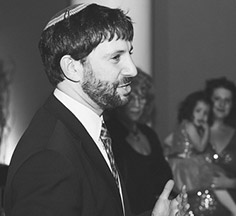This past summer, my family moved out of our cramped New York apartment and into a beautiful new home in western Massachusetts. The people are wonderful, there are farmstands selling local fruits and veggies everywhere, and there are lots of hiking trails minutes from our front door. But if you’ve ever moved to a new area, you know that moving entails learning what’s a little harder to come by. For the last few years, as Sukkot approached, I didn’t have to plan much when it came to buying a lulav and etrog: I would just hop on a short subway ride to an outdoor market and take my pick. Now, living further away from a large Jewish center, I needed to to plan in advance to make sure I and my community had this key ritual item.
The tension between the center and the periphery plays an important role in how the practice of waving the lulav unfolded over time. According to Leviticus 23:40, the lulav only needs to be waved on the first day of Sukkot. By the time of the Temple, that practice had been extended to each of the seven days inside the sacred precincts of the Temple, though throughout the rest of Israel it was still done only on the first day. However, once the Temple was destroyed, Rabban Yoḥanan ben Zakkai ruled that the lulav should be waved throughout Israel for seven days, zecher la-mikdash, in commemoration of the Temple (Mishnah Sukkah 3:12). With the destruction or churban of the center of holiness, the practice of waving the lulav for seven days was not cancelled but was rather extended to all places where Jews lived and worshipped. In commemoration of the Temple, the communities at the periphery were lifted to the role that the center had formally occupied, elevating communities and individuals to a level of holiness that had been reserved for the Temple.
Menachem Mendel of Chernobyl, the Chasidic rebbe who authored the commentary Me’or Einayim (Parshat Ha’azinu), sees another dynamic at play in the expansion of lulav waving, which offers valuable guidance at this moment in our political and social realities. He writes:
When a person is on a high spiritual level, she cleaves to God, who is sometimes described as a sanctuary (as in, “the Temple of the LORD are these [buildings]” (Jeremiah 7:4) and “the tent He had set among men” (Psalms 78:60)). But when she falls from that spiritual level, we can use mythic language and say that she is experiencing “the destruction of the Temple.”
There are times when we are at a higher or more sublime level of consciousness: things are clear, we are motivated, we’re in flow, the political leadership seems more or less aligned with our aspirations. In short, things seem like they are moving in the direction we want them to. For the Me’or Einayim, that is when we are on the level of “the Temple.” But, as we all know too well, we can’t and don’t stay in that place. The world and the people in it are threatened, the fantasy of perfection is shattered, and we have to deal with the reality of a broken world. Those are times we can metaphorically call “the destruction of the Temple.”
So what do we do when we inevitably fall into this state?
When she has come down from her prior level, she needs to strengthen herself and go back to God from the exact level that she is at, at that moment, in order to get to that higher level. That turn of consciousness can be called, “in commemoration of the Temple” [zecher la-mikdash]. Because she deeply believes that even on this lower level, God is also there, right now. For “there is no place that is empty of Him” (Tikkunei Zohar 91b).
When we realize we are no longer on the higher level where we once were, when things are not working out, we still do things “in commemoration of the Temple.” We remember that in some way, the Temple still exists, that God is still present, and we act in ways to honor that. There is still holiness in the world around us, but it needs our help to be fully realized. Even though we lack the clarity and energy – or the political power – we once had, does not mean that we are given permission to give up. Even though neither the metaphorical nor the real Temple stand any longer, we don’t toss aside the practice of waving the lulav every day. Instead, we hold fast to our faith (and our lulav) and shake it each day, trusting that it can raise us to the level where we once were.
Today, the “Temple” we thought we were living in as recently as a year ago no longer stands. Each day our planet grows warmer while regulations move backwards, nuclear war is somehow a real possibility for the first time in decades, anti-Semitism is back in the public square, healthcare is threatened, and our political discourse is in shambles. The halcyon days of that “Temple” are no longer with us. However, we can still wave the lulav every day of the holiday, just as we once did. We can lift ourselves and each other up, having faith that by remaining committed to our goals for a more fair and just world, we can yet return to the Temple.
Rabbi Seth Wax is the new Jewish Chaplain at Williams College in Williamstown, MA. He was until recently the rabbi at Congregation Mount Sinai in Brooklyn Heights, NY. He is an alumnus of the T’ruah Summer Fellowship in Human Rights Leadership.


